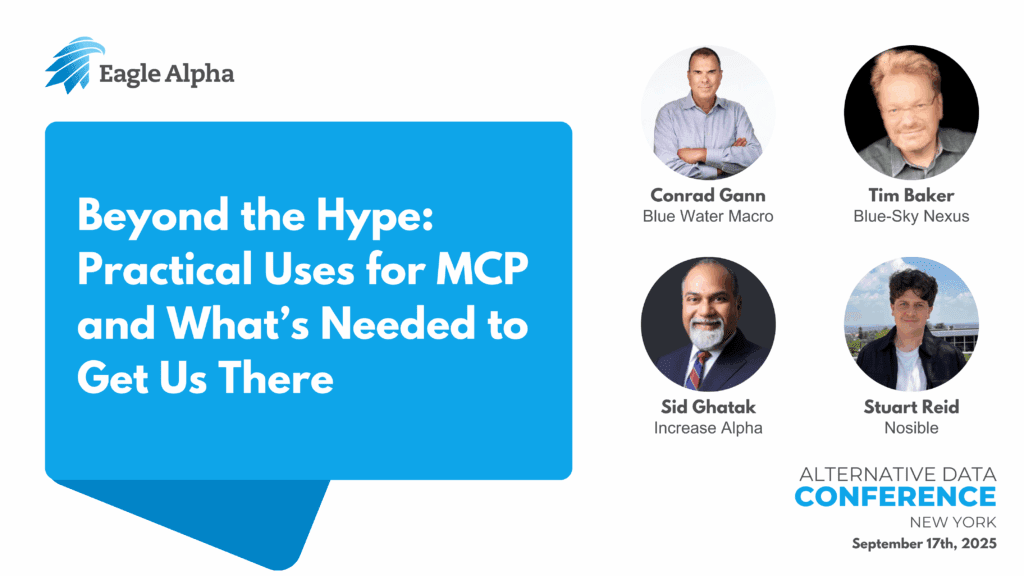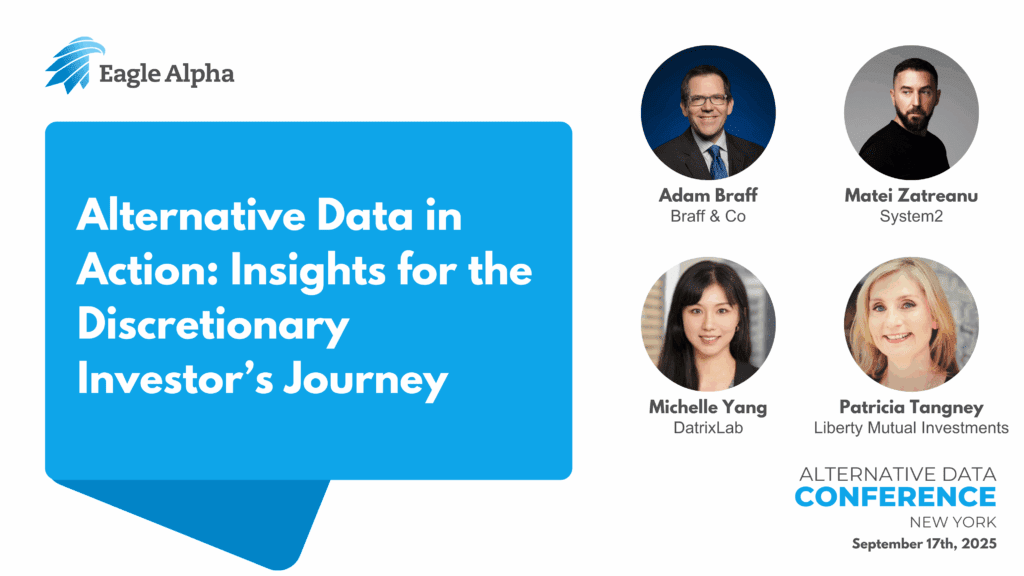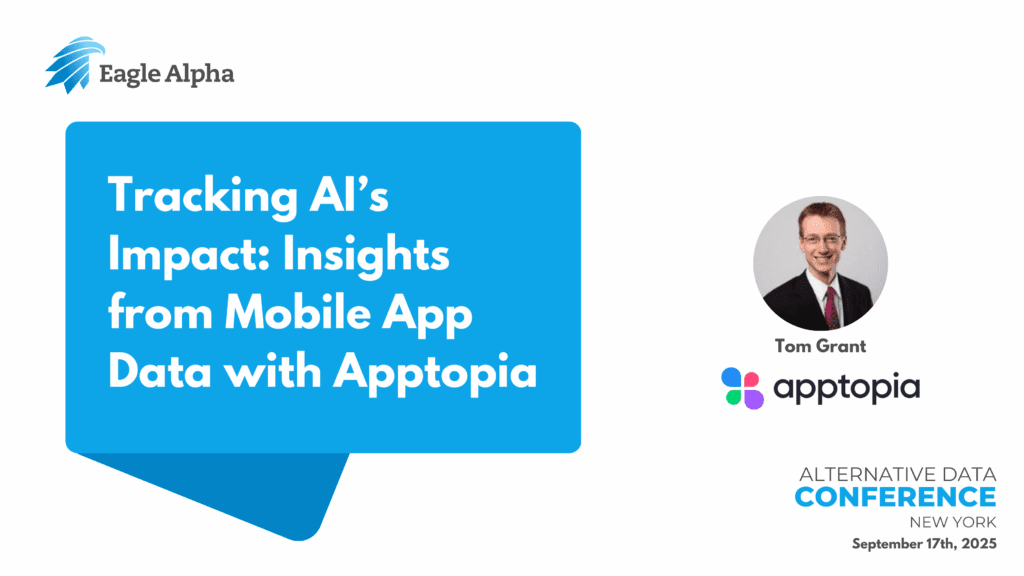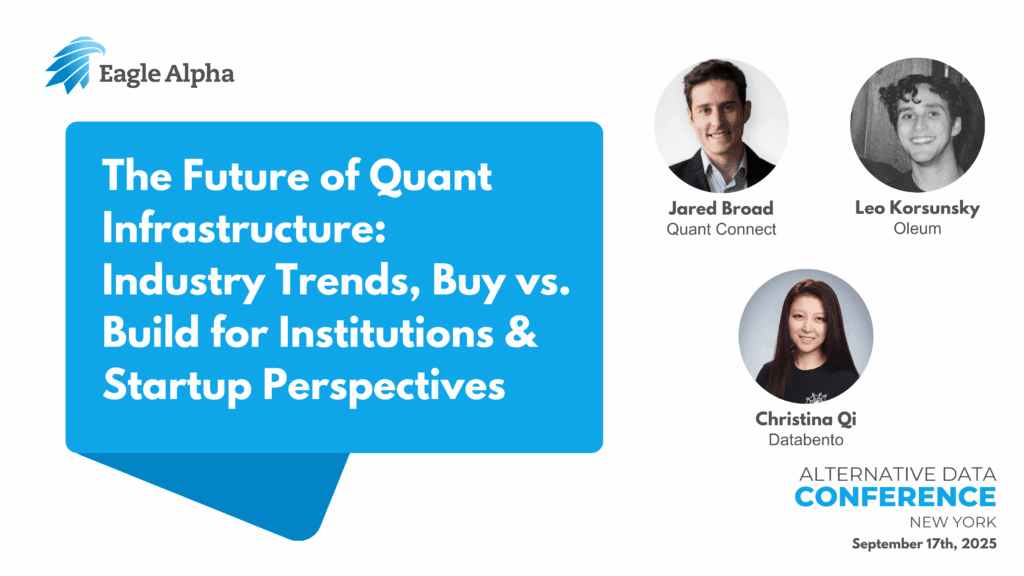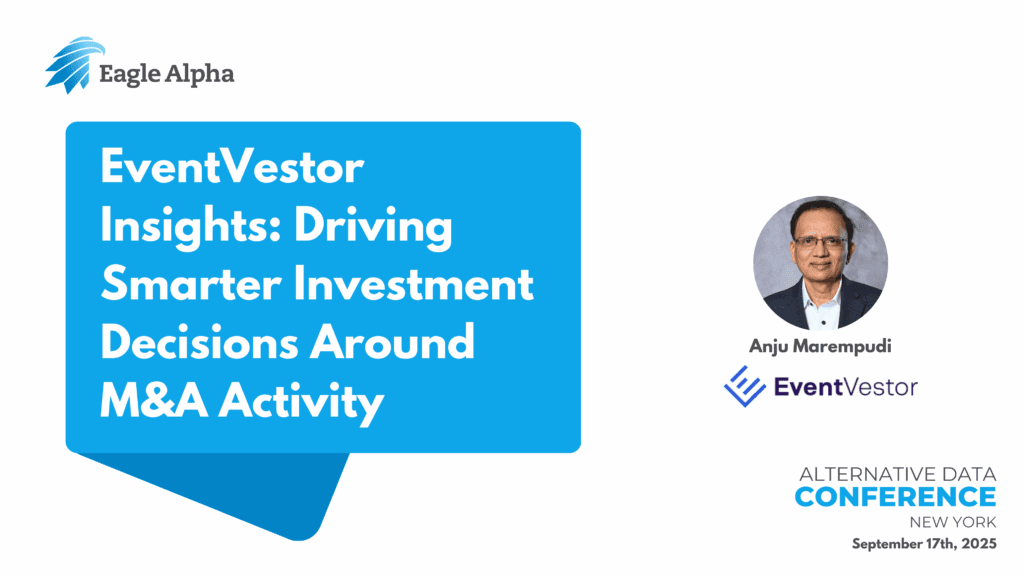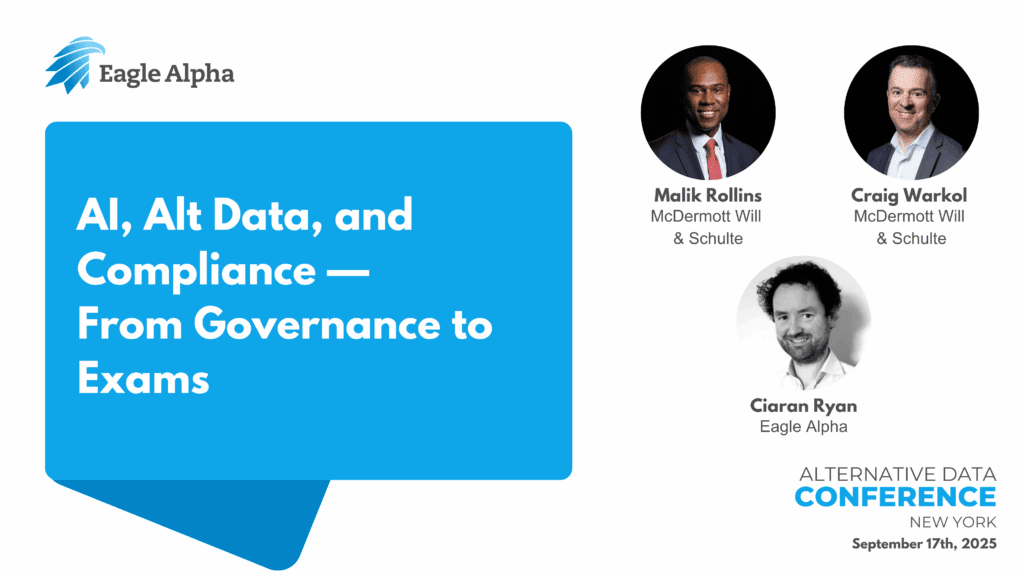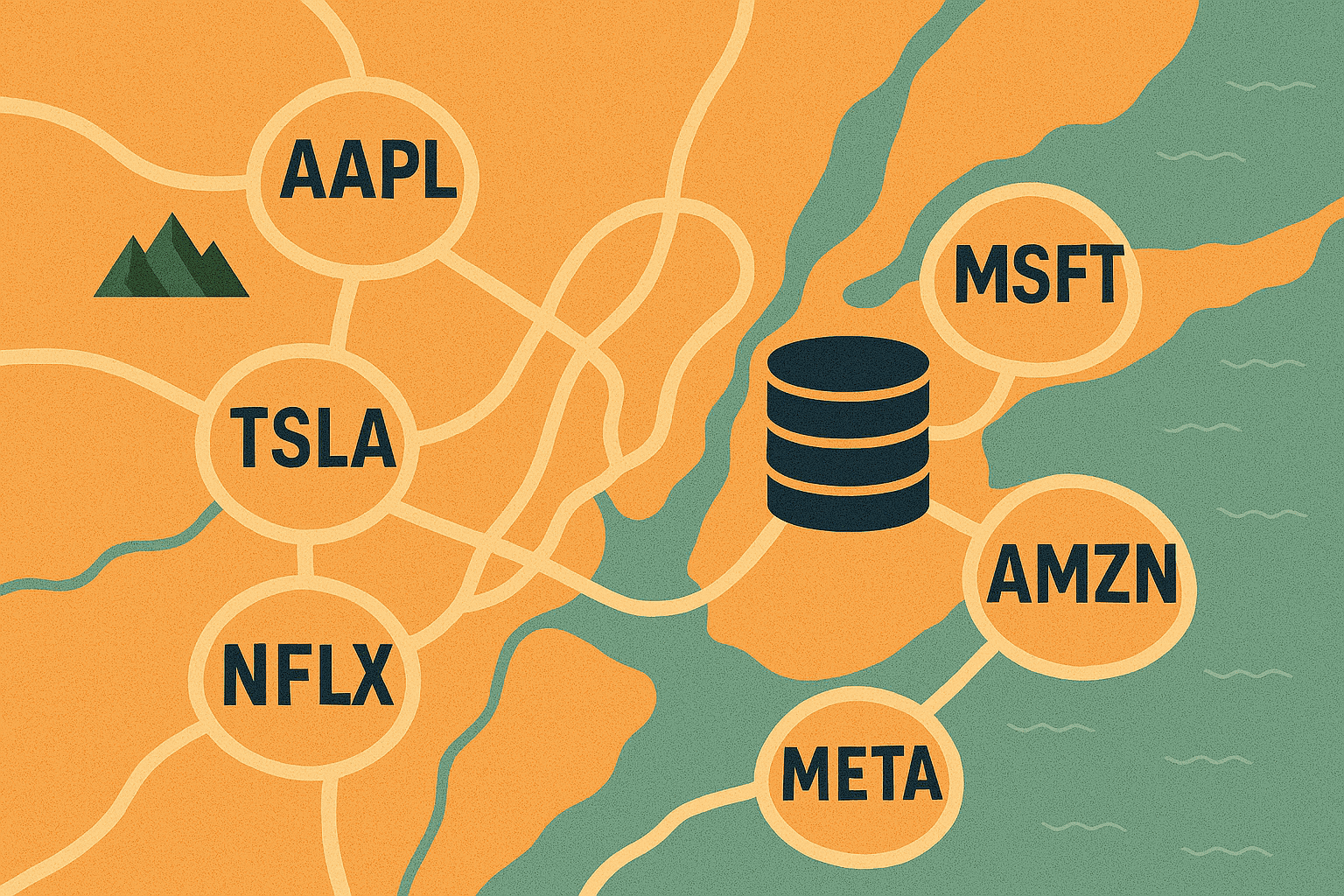Beyond the Hype: AI, MCP, and the Future of Alternative Data – Conference Highlights
The New York Alternative Data Conference 2025, hosted by Eagle Alpha, returned to Midtown Manhattan on September 17th, bringing together leaders across the alternative data ecosystem for a full day of insights, innovation, and networking. We welcomed a diverse mix of investors, data vendors, and thought leaders who gathered to explore the latest developments shaping the industry. From practical applications of Model Context Protocol (MCP) to the evolving role of AI and compliance in data usage, the event underscored how alternative data continues to push the boundaries of investment decision-making.
This year’s format gave attendees the flexibility to tailor their experience with multiple parallel tracks, exclusive partner-led sessions, and dedicated 1-1 meetings with vendors. The agenda featured a wide range of discussions, including forecasting innovations, quant infrastructure trends, and the future of macroeconomic data in a shifting policy environment.
Alongside deep-dive panels and fresh vendor showcases, participants had ample opportunities to exchange ideas, forge connections, and gain actionable insights. The day closed with a lively drinks reception, sponsored by SimilarWeb, concluding what proved to be one of Eagle Alpha’s most engaging and future-focused gatherings yet. The summary of selected discussions is presented below.
Practical Uses for MCP and What’s Needed to Get Us There
Summary
The session highlighted MCP’s role in connecting AI agents with mission-critical financial data and discussed limitations around authentication. Panelists explored how MCP reduces time-to-market for new predictive signals, particularly in time-series applications. The future success of MCP depends on robust authentication, standardized APIs, and improved context management for agents within narrow windows.
Key Takeaways
- MCPs can significantly streamline data workflows, enabling rapid model building and data evaluation.
- Authentication is crucial for secure adoption and enterprise use cases.
- Effective context engineering boosts AI performance; poor data quality undermines results.
Alternative Data in Action: Insights for the Discretionary Investor’s Journey
Summary
Panelists explored how operational efficiency and data storytelling create competitive edge for discretionary investors. Automation liberates analysts to focus on generating alpha. The panelists advocated for starting with well-defined questions and layering in automation, with AI best used to augment—not replace—human judgment.
Key Takeaways
- Smaller funds can compete by automating data tasks and focusing on investment insights.
- Hybrid teams combining investors, engineers, and data scientists can drive innovation.
- AI is most effective as a workflow support, not for unsupervised investment decisions.
Tracking AI’s Impact: Insights from Mobile App Data with Apptopia
Summary
Apptopia’s granular data reveals rapid growth of AI applications, led by ChatGPT’s broad adoption. While some feared core platforms would suffer, the impact has been selective, with strongest shifts observed in categories like search and social media. Engagement metrics are climbing, but resilience among top platforms is noteworthy.
Key Takeaways
- AI app market penetration is increasing, but has not disrupted core platforms as much as predicted.
- ChatGPT remains the market leader among AI apps, yet new players are growing quickly.
- Time spent on AI apps is rising, driving nuanced effects across tech sectors.
The Future of Quant Infrastructure: Industry Trends, Buy vs. Build for Institutions and Startup Perspectives
Summary
Panelists addressed operational and market trends in quant infrastructure, emphasizing ease-of-use and responsiveness to researcher needs. AI-driven automation is shortening trial cycles and facilitating more efficient adoption. The future points towards automated, AI-assisted environments with external platforms playing a crucial role.
Key Takeaways
- Usability and bottom-up adoption accelerate data infrastructure uptake.
- Institutions are shifting from proprietary builds to integrated external solutions.
- AI streamlines onboarding and evaluation processes for alternative data.
EventVestor Insights: Driving Smarter Investment Decisions Around M&A Activity
Summary
A case study of the Paramount-Skydance deal illustrated how event-driven strategies exploit evolving transaction narratives for trading and arbitrage. Point-in-time monitoring enhances evaluation of probabilities and volatility management. The approach informs not only M&A but also activism, capital raises, and clinical studies.
Key Takeaways
- Corporate events unfold in distinct tradable moments, offering alpha opportunities.
- Systematic tracking of event sequences helps manage risk and boost trading strategies.
- Other event types (activism, clinical trials) also benefit from structured research.
The Greeks – Data to Trade SWAPs, Derivatives and Structured Products
Summary
Panelists emphasized standardized analytics and expansion into new geographies, especially Asia-Pacific. Use cases ranged from hypothesis validation to regulatory compliance, highlighting data aggregation’s growing importance for both sell-side and hedge fund strategies. The evolution of client requirements centers on actionable insights and rapid delivery.
Key Takeaways
- Standardized, high-quality data is increasingly vital in derivatives and structured products.
- OTC market data breadth and sensitivity analytics offer competitive insights.
- Growing client demand for geographic coverage and faster, flexible delivery.
Macro Data at a Crossroads: A Global View of Data to Fill the Void in Government Statistics
Summary
The panel spotlighted limitations of traditional economic indicators and the growing reliance on alternative datasets during periods like the pandemic. Actionable alternative data and other public sources help traders anticipate macro surprises. The edge often lies in strong analytical frameworks and integrating diverse data streams for long/short positions.
Key Takeaways
- Alternative data sources are crucial for real-time macro forecasting during uncertainty.
- Hard data points enable proactive positioning in bonds, equities, and FX markets.
- Analytical frameworks and experience differentiate successful traders from peers.
AI, Alt Data, and Compliance: From Governance to Exams
Summary
Legal experts from McDermott Will & Schulte outlined how investment funds integrate AI — from augmenting research to marketing — and discussed critical compliance policies. Well-defined guidelines addressing permissions, type of AI, and data source controls are key. Data vendors must tackle AI hallucinations and diligence remains central, with trends pointing to increased diversity and complexity in procurement, especially in healthcare claims data. SEC oversight is adaptive, focusing on explicit risks rather than broad regulation for now.
Key Takeaways
- Clear policies and oversight are essential as AI adoption grows in funds.
- Compliance risks include improper data usage and accidental AI training with sensitive inputs.
- SEC is observing and learning, with enforcement focused on obvious violations.
New to Market & Fresh Features – Vendor Presentations
The session struck a balance between brand-new datasets coming to market and fresh product features from established providers. Far from being a simple feature release run-through, the session demonstrated how data providers are actively adapting to client needs—whether by scaling coverage, improving transparency, or layering in advanced analytics to make raw data more actionable.
The common thread across all presentations was a focus on timeliness, depth, and usability, as vendors compete to deliver insights that can move the needle in decision-making. Some highlights are presented below:
- Mill Street: Launched asset allocation and risk control models to complement their global MAER stock selection framework. The equity risk model gauges outlooks for stocks vs. bonds, or high vs. low-risk assets, typically over a 1–6 month horizon. Their small-cap/large-cap model helps identify the stage of the U.S. market and economic cycle.
- 3Ai: Introduced a new fundamental analytics tool built on systematic modeling, developed in collaboration with a major UK fund client. They are now producing ~1M pages of stock research weekly and have rolled out a co-pilot tool to enhance research workflows.
- Clootrack: Released a competitive analysis benchmark powered by consumer review data. Early signals such as product complaints, negative service sentiment, or discount-driven buying patterns can highlight margin leaks and churn risks long before quarterly disclosures.
- SimilarWeb: Expanded coverage to over 1B websites, 4M apps, and 250M product SKUs. Their new App Intelligence product tracks app-level usage alongside website subdomain traffic, offering deeper insight into DAU/MAU and digital performance.
- Verity: Added a Grant Vesting feed based on Form 4 data, capturing vesting shares and dates inferred from footnote schedules. While historical depth is limited, backfilling is underway.
- Context: Announced plans to expand beyond their EU focus, with Asia and LatAm coverage targeted for 2026.
- Geotab: Enhanced coverage granularity with geofencing capabilities for location-specific logistical insights.
- LunarCrush: Deployed a new MCP server to bolster performance and scalability of their platform.
Have questions or interested in learning more about our conferences? Reach out to us to learn about the upcoming events.

